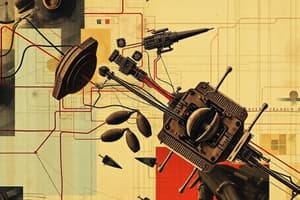Podcast
Questions and Answers
What is the primary function of a transducer in a nanosensor?
What is the primary function of a transducer in a nanosensor?
Which type of sensor is specifically designed to detect changes at a biochemical level?
Which type of sensor is specifically designed to detect changes at a biochemical level?
What feature of cantilever array sensors improves their precision?
What feature of cantilever array sensors improves their precision?
Which application utilizes cantilever array sensors for early diagnosis?
Which application utilizes cantilever array sensors for early diagnosis?
Signup and view all the answers
What is a defining characteristic of nanotube sensors?
What is a defining characteristic of nanotube sensors?
Signup and view all the answers
How are cantilever sensors able to detect the presence of cancer-associated molecules?
How are cantilever sensors able to detect the presence of cancer-associated molecules?
Signup and view all the answers
What mass detection limitation is associated with nanosensors in measuring DNA?
What mass detection limitation is associated with nanosensors in measuring DNA?
Signup and view all the answers
Which nanosensor application is specifically designed for monitoring blood glucose levels?
Which nanosensor application is specifically designed for monitoring blood glucose levels?
Signup and view all the answers
Study Notes
What is a Nanosensor?
- A sensor that operates at the atomic and molecular level
- Smaller size, lighter weight and less power compared to traditional sensors
- Can be used for data storage systems
- Can be classified as physical sensors, chemical sensors, and biosensors
Nanosensor Technology
- Biosensors are composed of:
- Bio receptors
- Transducers
- Detectors
Cantilever Array Sensors
- Working: Utilizes biochemical and physical processes to interact with a micro electromechanical system
- Features:
- Precision cantilevers with thickness tolerance of 300nm
- Precision resonance frequency achieved through special cantilever mounting
- Easy handling with vertical chip sidewalls and optional non-sticking surfaces
- Contamination-free storage
- Specifications:
- Rectangular shaped silicon bars with dimensions of 2.5mm width and 3mm height
- Duosensis Sensors: Contain 2 cantilevers per chip
- Octosensis Sensors: Contain 8 cantilevers per chip
Cantilever Array Sensor Applications
- Diabetes Mellitus Diagnosis: Detects small amounts of acetone in a patient's breath, potentially facilitating early diagnosis of diabetes
- Detection of Bacteria, Fungi, and Viruses: Antigens on cell membrane surfaces cause additional mass loading, leading to ultrasensitive detection by the device
- Cancer Diagnosis: Cancer-associated molecules binding to cantilevers cause changes in surface tension, bending the cantilever
- Single DNA molecule detection sensitivity
Nanotube Sensors
- Size/Shape: Coated with strands of DNA. Capable of detecting molecules at a concentration of one part per million
Nanotube Sensor Applications
- Blood Glucose Monitoring: Enzyme glucose oxidase is attached non-covalently
- Catalyzes glucose to produce hydrogen peroxide
- Provides potential for continuous blood glucose monitoring
Nanotube Sensor Platform
- Enables detection of molecules in the air or liquid environments
- Applications range from security to medical diagnostics
Studying That Suits You
Use AI to generate personalized quizzes and flashcards to suit your learning preferences.
Related Documents
Description
This quiz covers the fundamentals of nanosensors, including their operation at the atomic level, classification into various types, and specific technologies like cantilever array sensors. You'll learn about the components of biosensors and the unique features of nanosensor technology.




